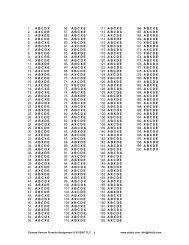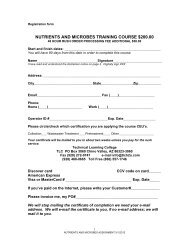Pump Primer 1 $100 - 8 Hours - Technical Learning College
Pump Primer 1 $100 - 8 Hours - Technical Learning College
Pump Primer 1 $100 - 8 Hours - Technical Learning College
Create successful ePaper yourself
Turn your PDF publications into a flip-book with our unique Google optimized e-Paper software.
Pressure<br />
By a fluid, we have a material in mind like water or air, two very common and important fluids.<br />
Water is incompressible, while air is very compressible, but both are fluids. Water has a definite<br />
volume; air does not. Water and air have low viscosity; that is, layers of them slide very easily<br />
on one another, and they quickly assume their permanent shapes when disturbed by rapid<br />
flows. Other fluids, such as molasses, may have high viscosity and take a long time to come to<br />
equilibrium, but they are no less fluids. The coefficient of viscosity is the ratio of the shearing<br />
force to the velocity gradient. Hydrostatics deals with permanent, time-independent states of<br />
fluids, so viscosity does not appear, except as discussed in the Introduction.<br />
A fluid, therefore, is a substance that cannot exert any permanent forces tangential to a<br />
boundary. Any force that it exerts on a boundary must be normal to the boundary. Such a force<br />
is proportional to the area on which it is exerted, and is called a pressure. We can imagine any<br />
surface in a fluid as dividing the fluid into parts pressing on each other, as if it were a thin<br />
material membrane, and so think of the pressure at any point in the fluid, not just at the<br />
boundaries. In order for any small element of the fluid to be in equilibrium, the pressure must be<br />
the same in all directions (or the element would move in the direction of least pressure), and if<br />
no other forces are acting on the body of the fluid, the pressure must be the same at all<br />
neighboring points.<br />
Therefore, in this case the pressure will be the same throughout the fluid, and the same in any<br />
direction at a point (Pascal's Principle). Pressure is expressed in units of force per unit area<br />
such as dyne/cm 2 , N/cm 2 (pascal), pounds/in 2 (psi) or pounds/ft 2 (psf). The axiom that if a<br />
certain volume of fluid were somehow made solid, the equilibrium of forces would not be<br />
disturbed is useful in reasoning about forces in fluids.<br />
<strong>Pump</strong> <strong>Primer</strong> I Course © 12/1/2012 (866) 557-1746 www.ABCTLC.com<br />
20
















